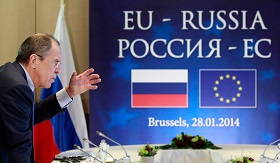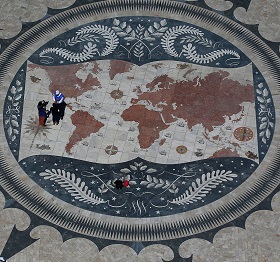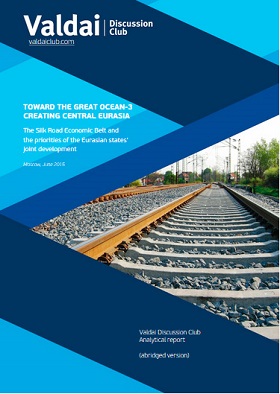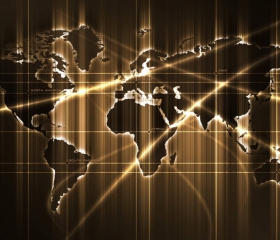Eurasian Geo-Economics: A View from Russia
N. Roerich, Novgorod bargaining, 1920
(no votes) |
(0 votes) |
PhD in Political Science, Director General of the Russian International Affairs Council, RIAC member
Ph.D. in Political Science, Leading Research Fellow, Head of the Center for Italian Studies, Institute of Europe of the Russian Academy of Sciences, Associate Professor at the National Research University Higher School of Economics, RIAC Expert
Geopolitical rivalry in Ukraine has made Eurasia the key positive area of Russian policy. The multi-vector concept that had prevailed in foreign policy ideology since the late 1990s has been revised drastically. Instead of positive cooperation with all the world development centres, Russia has been forced to compensate for the avalanche-like collapse of its partnership with the West by stepping up its efforts to establish such links in other directions.
Russia and Eurasia: Main Trends
The Eurasian vector is one of the key areas of Russian foreign policy today. Partnerships with major Asia-Pacific and South Asian countries, as well as cooperation with the CIS countries, has traditionally been a Russian priority. That priority has become more pronounced in recent years. It is manifested above all in the creation of the Eurasian Economic Union (EEU), an international association of five former Soviet economies: Belarus, Kazakhstan and Russia, and later Armenia and Kyrgyzstan. It is also evident in the growing partnership with Asia-Pacific countries. Russia’s presidency of the Asia-Pacific Economic Cooperation (APEC) forum in 2012 was important in this respect. The term “Eurasia” is mentioned more frequently in official documents and speeches by political leaders. Essentially, the Eurasian vector now refers to cooperation with former Soviet countries which have maintained partnership and allied relations with Russia, as well as with major non-Western powers on the continent.
The revolution and civil war in Ukraine, followed by the sharp deterioration of relations with the United States and the European Union, gave new relevance to the Eurasian vector. What was one of the priorities has become the main priority. Before relations with the West began to worsen, Eurasian integration was overshadowed by relations with the European Union. Rapprochement, trade cooperation and the development of humanitarian links with the European Union dominated foreign policy discourse, although they were never seen as the sole alternative. Cooperation with the United States in the security sphere was at least as important. Of course, Russia had its differences with both these players, and gradually these differences increased. However, until very recently, its trade and political ties with the West kept these relations in a positive field. The events in Ukraine meant that the West was still a priority. However, this priority now has acquired a distinct negative character, both for Russia and for Western countries. Military and political tensions have grown dramatically. The sanctions have dealt a blow to trade and economic links. Many integration and even partnership projects with the European Union have been abandoned.
The most important consequence has been cutting Russia off from a powerful source of its development and modernization. The sanctions have limited access to Western financial capital markets, as well as to many critical technologies. It has become vital for Russia to seek new sources of growth and development models to enable it to move forward in spite of its isolation from the West. Geopolitical rivalry in Ukraine has made Eurasia the key positive area of Russian policy. The multi-vector concept that had prevailed in foreign policy ideology since the late 1990s has been revised drastically. Instead of positive cooperation with all the world development centres, Russia has been forced to compensate for the avalanche-like collapse of its partnership with the West by stepping up its efforts to establish such links in other directions.
Obviously, Russia’s partnership with the United States, the European Union and other Western countries and organizations will have to be restored over a long period of time and on a qualitatively new basis. Cutting itself off from some countries in favour of others is not easy in a global world. Eurasia may offer new opportunities for Russia to cooperate with the West. After all, the European Union is also part of the Eurasian space (at least geographically). However, at this juncture, the Eurasian vector, without Europe and the West, is emerging as the driver of Russian foreign policy. Its vision of the world now is much less oriented towards Europe. So far the Ukrainian crisis has spurred on this change (although common sense tells us that the problem can only be solved through the joint efforts of Russia, the European Union and Ukraine itself).
Equally important developments are taking place in other parts of Eurasia. In the East, the Chinese economy is forging ahead, although there have been signs of a slowdown in recent years. Having used up part of the growth potential of infrastructure development within the country, China is showing greater interest in investing in transnational infrastructure corridors. The Silk Road Economic Belt project – the transport route across the western parts of China, Central Asian countries, Kazakhstan and Russia – has become the key initiative. Its final destinations are the European Union and the Middle East. Although the project is still in its infancy, its very discussion has had great resonance. The emergence of such a route spells major economic and political changes in the region. Russia sees the project as an opportunity, not a challenge. It seeks close cooperation with China, EEU members and other countries in the region in developing the Silk Road Economic Belt.
The signs of a future competition between China and the United States in the Asia Pacific Region and in Central Asia promise to become an important political factor in Eurasia. Today, these two economies are heavily dependent on each other. Both states tread warily in dealing with mutual political disputes and differences. However, mutual suspicions between Washington and Beijing are growing in the military-political field. China is actively modernizing and developing its armed forces, and is pursuing an active policy in the zone of its regional interests (for example, in the South China Sea). The United States already has a powerful military presence in the region. Although it has to some extent switched its interest to the “Russian threat”, Washington does not discount the potential challenge on the part of China. The U.S. pivot towards Asia could have both economic and military-political consequences. Being mindful of this, China seeks to “secure its rear” in the long-term, at least in the North and South. In this context, a partnership with Russia is of key importance here in the military sense, and the Silk Road Economic Belt is of key importance in the economic sense.
Significant processes are also taking place on the western tip of the continent. They are not confined to the Ukrainian issue and the containment of Russia. The development of the Transatlantic Trade and Investment Partnership appear to be important from an economic perspective. In effect, we are looking at the creation of an economic alliance between the European Union and the United States, the world’s two biggest economies. Because both players are already closely integrated militarily within NATO, the new economic project may create a massive power centre. If the United States succeeds in building the analogous Trans-Pacific Partnership in the Pacific Rim, the centre would become truly global. In the future, the new pole could successfully contain other power centres (such as Russia), or force them to adapt to the new rules of the game in the framework of “pluralistic unipolarity” (this applies to China, India and Brazil). The European Union, United States and their Asia Pacific allies still have time to build such a model because neither China, nor other powers, are in a hurry to ruin partnership relations with the West as a whole. The building of such a model, which would adapt other players as well, and making that model mutually beneficial would mark a major victory of the United States and its allies in Europe and the Asia-Pacific Region. Having said that, it would involve solving a number of internal problems, such as the financial crisis in Greece.
In any case, it remains to be seen whether China on the one side, and the United States and its allies on the other, will be partners or rivals in the future world. More importantly, whatever the outcome will be, it will be a game changer for all players. Russia too will need to adapt, feeling for a place in the new world and, if possible, actively contributing to its formation.
Developments in the Greater Middle East play a key role. The region is fast descending into uncontrolled chaos. The central event is the rapid rise of the Islamic State of Iraq and Levant (ISIL), an entity which is already attracting radical Islamism and exerting colossal military, political and ideological influence. It is symptomatic that ISIL has formed in two crisis states, Iraq and Syria. The number of such states in the region is growing. They are extremely vulnerable to terrorist groups. Right now, crushing ISIL using military means appears to be impossible, because of the lack of unity in the global community and its inability to solve the problem through joint actions.
Meanwhile, ISIL is becoming more and more of a threat to the security of the West, Russia, China, India, and the allies of these countries. There are signs that ISIL is penetrating into the North Caucasus, Central Asia and the western parts of China. ISIL is seen as a threat even in Afghanistan, which used to be regarded as one of the main seats of terrorism. Against the background of ISIL, the Taliban in Afghanistan is beginning to be treated by the country’s authorities as a possible negotiating partner.
Iran is emerging as an important stabilizing factor in the Middle East. The sanctions have taken a heavy toll of the country’s economy, but it looks as if Iran has stood its ground in its political showdown with the West. Iran’s military potential is growing, as is its political role in the region. Iranian elites are committed to technological modernization. Sanctions have caused it to strengthen its ties with China. Iran is one of several final stops on the Silk Road Economic Belt.
Finally, Kazakhstan, which is located in the heart of Eurasia, has been playing an ever more noticeable role over the past decade. The country has scored some major achievements. On the one hand, it has built a stable system of state institutions and a robust economy. Although the economy is exposed to the risks of energy price fluctuations, Kazakhstan is steadily modernizing and renewing its economy. On the other hand, Kazakhstan has managed to establish friendly ties with all the key power centres – Russia, China, the European Union and the United States. The country plays an important role in the Eurasian Economic Union and in the future Silk Road Economic Belt. At the same time, Kazakhstan is under heavy security pressure from Central Asian challenges, a pressure that may grow in the future. This adds an extra political dimension to the country’s partnership with key global and regional players. Transformations in Eurasia will test the strength of Kazakhstan’s economy and state system.
It is no exaggeration to say that we are witnessing sweeping geopolitical changes – the result of the combined pressure of contradictions and political processes on the entire Eurasian continent. After the end of the Cold War, it has become a truism that the old bipolar world has receded into the past and a new one has yet to be formed. Indeed, for quarter of a century, Eurasia and the world in general have been in a suspended state. The pause is likely to be broken very soon by the major changes focused on Eurasia.
What should Russia do in this situation? What are its interests? What opportunities and threats may these changes bring for Russia? What are its strengths and weaknesses? How can Russia make the most of its advantages to forge constructive relations with the external world and find the most advantageous formula for a new world order? An attempt will be made below to answer these questions. Although Russia wields far less influence in international affairs than the former USSR, it is still a significant player in the world arena. It can play a constructive role in terms of ideas, and by contributing to the solution of existing problems.
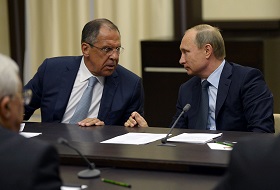
Ivan Timofeev:
7 Trends for Russian Foreign Policy You Need
to Know
Russia’s Interests
Russia’s key interest in Eurasia is determined by the goal of the country’s development. Its economic and human resources are limited. Successful development calls for their concentration. Scattering resources to engage in geopolitical competition would inevitably divert resources and cause the country to lag behind others in terms of its development. It will hardly be possible to avoid all the security challenges. But concentrating on the key challenges, forming a coalition with other interested parties and having a maximum number of friendly or neutral neighbours is a task that must be addressed.
Therefore, Russia’s prime interest in Eurasia can be defined in terms of development diplomacy: increasing the number of friendly or neutral forces, concentrating on the problems that cannot be solved without a coalition of the largest number of participants. In practice, this means developing partnership relations with Collective Security Treaty Organization (CSTO), EEU and Shanghai Cooperation Organisation (SCO) member countries. Equally important are resolving the Ukraine problem, normalization of relations with the West as whole and ending military-political competition with the West. The focus should be on countering terrorism, religious extremism, drug trafficking and destabilization of the country’s southern borders.
This leads to the second important interest – preventing growing chaos in the Eurasian macro-region, the increase of hot spots, crisis zones and weak states. These areas are the spawning ground for terrorists and extremists of every stripe, undermining the system of regional security. Creating a prosperous and stable neighbourhood is as important for Russia as it is for its neighbours. Even geographically remote conflicts in Eurasia have a negative impact on the country’s security, forcing it to expend the scarce forces and assets that it has. Preserving stability is an important task for Russia’s partners as well.
That stability should not be interpreted in the conservative sense. It’s another matter entirely. Political and economic systems are living organisms. They are given to crises which must be used to renew and reform these systems. Artificial conservation of dysfunctional regimes or systems will only lead to greater upheavals. This is why Russia should pursue a flexible policy and support healthy and pragmatic reforms at home and in neighbouring countries. Such support should be underpinned by the ideology of joint development. A pragmatic material result is more important than the kind of blind adherence to speculative political doctrines that has become increasingly apparent in the actions of our Western partners.
Russia’s third interest in Eurasia is related to this idea of co-development: active participation in economic and humanitarian integration projects, reducing or eliminating barriers in the way of moving capital, goods and labour. Russia should also join ambitious infrastructure projects and use the country’s transit potential. This interest implies building the Eurasian Economic Union in the near or medium term. Legislation and industry standards in the main areas of integration need to be harmonized, and the union’s institutional base need to be strengthened. Concentration on economic issues is a must for the Union. It is in Russia’s interest to build a solid foundation for cooperation with its partners in the EEU, rather than focusing on costly political projects. If integration yields tangible economic results, that is sure to strengthen equal political relations.
It is also important that the EEU can be the basis for promoting economic relations with other countries and economic associations. A free trade zone with Vietnam was established in 2015. Coordination of Eurasian economic integration with the Chinese Silk Road Economic Belt project is discussed on the highest political level . In spite of the grave crisis in relations with the European Union, the question has been raised of integration between the EU and the EEU. The European Union cannot afford to ignore the existence of the EEU in its interactions with Belarus, Armenia and Central Asia countries, which spells the need to work out a mutually acceptable modus vivendi between the European Union and the EEU and at least to create a forum for conducting a dialogue. The outlines of such interaction are still unclear, but the fact that the question has been raised shows that there is a need for instruments that would help overcome the contradictions. The EEU and other institutions may revisit the issue of a Greater Europe from Lisbon to Vladivostok. The concept may morph into a concept of Greater Eurasia.
In the political sphere, it is in Russia’s interests to develop regional security organizations, most notably the CSTO. However, dialogue on security issues should also be pursued within the SCO framework. That organization is also a proper venue for discussing economic issues. It is unlikely that the SCO will become an integration project at this stage. But it has serious potential as a discussion platform, bridging gaps and coordinating the policies of its member countries.
It is in Russia’s interests to avoid deepening existing, and creating new, schisms in Eurasia. This is not to say that all the countries in the region should be brought to a common economic and political denominator. That is impossible, and indeed unnecessary, given the complexity of the modern world and the diversity of cultures and development models. Rather, it is a question of building mechanisms for addressing common problems. The 40-year experience of the OSCE merits a thorough analysis. In tackling the problem of the institutional deficit in Eurasia, it is necessary to take into account the mistakes and complexities of building security in Europe, where new rifts and conflicts unfortunately tend to arise.
Finally, another important Russian interest is to establish the country’s role as an equal, constructive and creative partner. Many foreign media, especially in the West, spread negative stereotypes about the country. Russia is seen as a threat and is described as an unreliable and fragile state. That image was in place even before the events in Ukraine. Work in the information field alone (though necessary) is not sufficient. Concrete results are needed in the economy, in the country’s development, in reliable state management and in effective integration projects. Sooner or later, achieving these results will change the country’s image in the world.
Russia in Eurasia: Strengths and Weaknesses
To promote Russia’s interests and foster mutually beneficial relations with its Eurasian partners, there needs to be a clear understanding of the country’s strengths and weaknesses. A rational balance of advantages and disadvantages is the basis for a pragmatic policy in the region.
One of Russia’s main strengths is its geographical position. Russia has land and sea access to most key points in Eurasia. The advantage is augmented by the fact that this vast space is linked by a common transport and infrastructure network. Of course, whether Russia can be a bridge between different parts of Eurasia right now is open to question. For example, Russia still cannot claim to be a major transport corridor. But it can play on several Eurasian stages, an advantage enjoyed by no other country, even though Russia’s role is secondary in some areas.
Another advantage is the scale of the Russian economy, its potential to be an attractive market and make a tangible contribution to regional economic and infrastructure projects. It goes without saying that the Russian economy cannot be compared to those of the European Union or China. It is poorly diversified and is dependent upon supplying commodities to external markets. Nevertheless, its sheer size and the abundance of resources it has to offer are sure to attract attention. Coupled with a competent technological policy and financial capitalization, the Russian economy has long-term growth and development prospects, in spite of the current crisis. Even a minority contribution to common projects makes Russia a noticeable participant.
The third advantage is the capacity to make a tangible contribution to the security of economic projects in the region as a whole. Russia has powerful and mobile armed forces capable of responding quickly to crisis situations and assisting its partners and allies. This could be an important resource in implementing large-scale infrastructure projects. For example, building the Silk Road Economic Belt involves a range of security risks which Russia can help to reduce significantly. Mechanisms of interaction with partners on specific projects need to be thought out, or else universal mechanisms for joint crisis response put in place. Active participation in regional organizations, such as the CSTO and the SCO, is also an advantage.
The fourth advantage is Russia’s education potential. Though its economy is peripheral, Russia has qualified experts capable of implementing diverse economic projects. Besides, the Russian educational infrastructure can be used as part of humanitarian cooperation with all the partner countries.
The fifth advantage is extensive experience of interacting with the countries and cultures in the region, an awareness of their diversity and cultural flexibility. Russia does not impose ideological doctrines on its neighbours and favours pragmatic partnership in common interests. Russia is trusted by many countries in the region.
There are also a number of drawbacks. First, we have the complexities of economic development, the poorly diversified economy and the enfeebled technological base. The Russian economic system is not flexible enough and has a growing government sector. Low labour productivity is compounded by demographic problems, slow population growth, an ageing population and a high mortality rate. The collapse of the USSR triggered rapid deindustrialization. New industry is in its infancy. Corruption hampers economic development. There is a limited number of global companies, and there could have been more. And infrastructure problems need to be solved. This applies above all to the port, road and railway infrastructure. In spite of some progress in the past ten years, the competitiveness of the Russian economy continues to be undermined by poor infrastructure. Involvement in integration projects may become an incentive to overcome these systemic problems.
The second drawback is regional demographic imbalances. Russia’s population is distributed very unevenly. The bulk of the population is concentrated in the western part of the country. The resources of Siberia and the Far East are being developed slowly because of the shortage of human resources. These parts of Russia are the most vulnerable in terms of population shrinkage.
The third drawback is growing competition with the West, which has sharpened as a result of the Ukrainian crisis. Competition diverts resources to military needs, hinders partnership in addressing common problems, and creates zones of instability which in the future will also divert considerable resources. An arms race is a possibility, and it too would put a strain on the nation. And this despite the fact that, unlike during the Cold War, Russia and the West do not have any fundamental ideological differences, while the number of common threats is growing. Although competition with the West has prompted Russia to move more actively into Eurasia, it would be better off if it pursued a multi-vector policy. The deterioration of relations with the West indirectly damages relations with other players. In Russia, the West itself is losing an economic and political partner. The best scenario for Russia would be to deepen Eurasian integration while simultaneously exiting from the confrontation with the West, using the West’s potential for its own development.
Russia in Eurasia: Risks and Opportunities
Russia’s strengths and weaknesses should be set side by side with the regional risks and opportunities, because the former are in many ways internal and are by and large Russia’s own problem, while the latter have a regional character and call for multilateral approaches.
Among the key risks is the sharpening of regional conflicts. One such area is Afghanistan and Central Asia. Another is destabilization in the Caucasus due to strengthened positions of Islamic groups. Nor can we rule out the revival of frozen conflicts in the region, notably between Armenia and Azerbaijan. The conflict in that part of Eurasia is closely linked with the prospects of the Silk Road Economic Belt and also affects the interests of the EEU. A serious destabilization of the situation may put the creation and functioning of the transport infrastructure under threat. This is a very important issue for Eurasian economic integration in terms of the freedom of movement of people and goods. A serious crisis would create a threat on both counts.
The situation may take a turn for the worse due to contradictions between the global players, namely, between China and the United States, and between Russia and the United States. The United States can hardly be blamed for the growing chaos in global politics and in specific regions. That process goes far beyond U.S. foreign policy. The United States is probably not interested in upsetting the balance in the region, although many of its actions are open to serious criticism. The problem is that the United States perceives Russia and China more as rivals in Central Asia (the reverse is also true), which creates a mutual temptation to derail the regional economic projects of the other side. It is necessary to maintain the dialogue between Russia, the United States and China on Afghanistan and Central Asia, including in the light of the threat from ISIL and other radical groups.
The second risk is purely economic. Any economic project is aimed at deriving profit. And any project risks to turn out unprofitable. The success of the Silk Road Economic Belt is today almost taken for granted. And yet its economic returns even in the longer term are uncertain. What will happen if the new infrastructure is not in demand or, for example, if transport by sea turns out to be more effective and economical? Will the partners be prepared to keep it afloat and develop it no matter what?
The EEU is exposed to a similar risk. Quick economic returns of integration cannot be guaranteed, while the development of the Union will require resources. The situation is aggravated by the economic problems in all the EEU countries as their markets shrink under external pressure. Building a successful project against the background of economic downturn is a difficult task. Forming an economic alliance increases the interdependence of economic risks and crises, which may have a negative impact on public perception of integration within the Union’s member states.
Herein lies a third risk: the temptation to politicize economic projects, especially if they fail to turn a profit. If integration does not deliver the expected economic result, politicizing it would make them even more wasteful. For Russia, the burden of political liabilities will be double, because of the limited resources. Russia may face a difficult choice between more spending and being sidelined from regional initiatives. The politicization of economic integration that runs ahead of real economic processes may seriously undermine Russia’s image (blames of “imperial ambitions”) and that of the entire EEU (naming it “USSR 2.0”). It is very important for Russia not to waste the “soft power” potential it still has in the region, because it acts as a serious support and cementing element of the alliance in situations where economic processes are not going as fast as expected because of the economic crisis.
The institutionalization of economic integration within the EEU involves yet another risk, namely, the risk that the new EEU norms and rules of economic activity could contradict those that functioned successfully before in the bilateral format, or could even cancel them. It is important that integration should open new possibilities, rather than setting obstacles, and should preserve the positive experience of cooperation accumulated over the last 25 years.
However, the above-mentioned risks can be translated into opportunities. Participation in large-scale economic projects is a step forward in any case, even if the projects fail. It offers a safeguard against economic isolation, forms an alternative pole of growth and development, reduces costs and boosts economic efficiency. Economic success in turn should reduce political risks. At the end of the day, the main cause of political upheavals is a low quality of life, weak institutions and economic mismanagement. Tackling these problems together should reduce political risks.
It is also important that key players in Eurasia have common “ambitious goals”. These goals have a transformative, creative character. This attracts the attention of the rest of the world more than adherence to abstract political doctrines does.
First published as a part of the Astana Club’s Report “Geo-Economics of Eurasia”
(no votes) |
(0 votes) |



